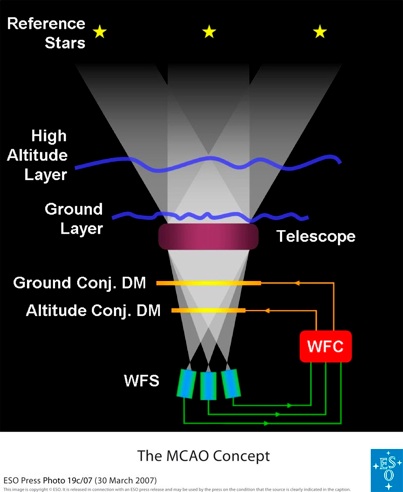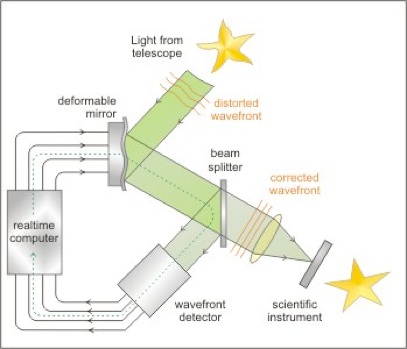Adaptive Optics
Telescopes on the ground suffer from a blurring effect introduced by atmospheric turbulence. This turbulence causes the stars to twinkle in a way that delights poets but frustrates astronomers, since it smears out the fine details of the images. However, with adaptive optics (AO) techniques, this major drawback can be overcome so that the telescope produces images that are as sharp as theoretically possible, i.e. approaching conditions in space. Adaptive optics systems work by means of a computer-controlled deformable mirror that counteracts the image distortion introduced by atmospheric turbulence. It is based on real-time optical corrections computed from image data obtained by a wavefront sensor (a special camera) at very high speed, many hundreds of times each second.
Present AO systems can only correct the effect of atmospheric turbulence in a very small region of the sky — typically 15 arcseconds or less — the correction degrading very quickly when moving away from the central axis. Engineers have therefore developed new techniques to overcome this limitation, one of which is multi-conjugate adaptive optics. MAD uses two or more guide stars instead of one as references to remove the blur caused by atmospheric turbulence over a field of view thirty times larger than existing techniques.
The Multi-Conjugate Adaptive Optics technique is based on probing the atmospheric turbulence on a large volume of atmosphere by means of several wavefront sensors (WFS), which point at different locations in the observed field of view, and by means of several deformable mirrors - optically conjugated at different altitudes on the atmosphere above the telescope - which correct for the atmospheric disturbance. The signals provided by the wavefront sensors are reconstructed to generate accurate information on the vertical structure of the atmospheric turbulence and then recombined in an optimal way to accomplish the best correction with the deformable mirrors located in the AO system. Since the wavefront sensors look at different directions in the field of view, the resulting correction is then optimized and homogeneously maximized across it. MAD makes use of two deformable mirrors, optically conjugated at 0 and 8.5 kilometres above the telescope.


The Multi-Conjugate Adaptive Optics Demonstrator MAD is an advanced generation adaptive optics system, capable of compensating for the atmospheric turbulence disturbance on a large field of view (FoV) on the sky. It can successfully correct a 1-2 arcmin FoV, much larger than the ~15 arcsec typically provided by the existing adaptive optics facilities.
MAD was built by ESO in collaboration with the Astronomical Observatories of Arcetri and Padova (Italy) and the Faculdade de Ciencias da Universidade de Lisboa (Portugal), as a pathfinder for 2nd generation VLT instrumentation and the European Extremely Large Telescope project.
More details can be found in the PR ESO 19/07.